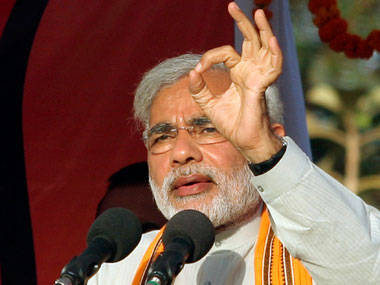Gujarat Chief Minister Narendra Modi on Saturday sought to tamp down media speculation that his three-day fast program was aimed at projecting himself as a candidate for Prime Minister. “I don’t understand why this angle is being given,” Modi told CNN-IBN’s TM Veeraraghav. His intention in organising the Sadbhavana Mission, he said, was “fairly straightforward: Gujarat is being acknowledged for its development model and good governance. We want to provide an ideological thrust to it, and that’s what this Mission seeks to accomplish.” [caption id=“attachment_86419” align=“alignleft” width=“380” caption=“Narendra Modi on Saturday sought to tamp down media speculation that his three-day fast program was aimed at projecting himself as a candidate for Prime Minister. Reuters”]  [/caption] But responding to persistent questioning about whether he was inclined to play a larger role in national politics, Modi conceded that as a faithful party worker, he would do whatever the party or the nation required of him. “Every Chief Minister in India by default makes a contribution to national politics,” he elaborated. “Even if I’m a municipality president, and if I run it efficiently, is it not national service? In that sense, the work that I am doing in Gujarat is already in the national service.” “I am a mazdoor insaan,” said Modi. “I do whatever the party wants me to do…. The work that we do is for the party and for the nation.” More specifically, asked for the reasons for his undertaking his fast at this stage, Modi said that the Sadbhavana Mission was intended to tell the world that the Gujarat developmental model – which was encapsulated in the slogan ‘sabka saath, sabka vikaas’ (Participation of everyone, progress for everyone) – was the “right path of development” for the whole of India. “It isn’t enough for me that Gujarat gets acknowledged for good governance and its developmental model and its progress. The Gujarat model should be a model for the rest of India too,” Modi said. His three-day fast, he said, was intended to “din it into” people who don’t fully know that this is the right way. “Everyone in India should understand that this is the right path of development. I have to bring people around to that. I have to give extra effort to do that.” Elaborating further on the Gujarat model and how it was different from others, Modi said that at present, much of what passed for developmental work was based on a piecemeal approach. “Throw some here and there, and get on with it.” And development, he said, was invariably tied up with vote-bank politics. “I’ve been convinced that development and progress needs to be put on a firm footing. A piecemeal approach favours no one. Which is I worked on the theme of Sabka saath, sabka vikaas, which has proved very successful. We don’t adopt a piecemeal approach. Whatever progress we make will be shared and shared alike among everyone,” Modi said. Asked if the concept of sadbhavana did not extend to the government ensuring that the victims of the 2002 riots – Hindus and Muslims – secured justice, Modi said that, first of all, he had never invoked the name of any religious denomination.“ The nation’s “misfortune”, he said, was that leaders only thought along religious lines. “We don’t do that. If there is a section or a locality that has remained backward relative to others – perhaps because it did not have a good leadership or because it lacked natural resources, we should focus on developing that section too.” Asked if perhaps the fast was intended as a (premature) celebration of the Supreme Court verdict in the Gulbarg Society case associated with the 2002 riots, Modi said he was on a fast, and wasn’t celebrating. As for the riots cases, “Is Modi named in any fir in any case in any police station?… Nine years have gone by, the reality on the ground is different, yet you go on and on… Watch the video of CNN-IBN’s interview with Narendra Modi
In an interview to CNN-IBN, Modi explains that he wants the Gujarat model of development to become the template for the whole of India.
Advertisement
End of Article


)
)
)
)
)
)
)
)
)



